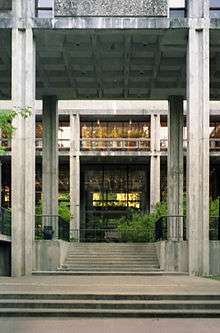Long Range Development Plan (UCSC)
University of California, Santa Cruz's Long Range Development Plan (LRDP for short) is a plan to accommodate up to 19,500 students if it becomes necessary by 2020.[1] UCSC administrators and the UC Regents have stated that they are approaching the LRDP in a sustainable manner. The LRDP also contains an Environmental Impact Report (EIR), which addresses some potential impacts to the surrounding environment in water supply, ecology, traffic, housing and more. The EIR is required by the California Environmental Quality Act.
Reasons for growth
California’s population of University of California–eligible high school graduates is continuing to grow. UCSC, along with the other UC campuses, is expected to meet the growing demand to get into a UC. This also includes the expected transfer students from the state’s community colleges.
The expansion of the campus has been deemed necessary by the UC Regents to satisfy the demand from qualified high-school graduates in California. The faculty-led Strategic Futures Community (SFC) stated that having 25,000 students would be needed in order to have every program rank in the top 25% of public research universities. The enrollment top was reduced to 21,000 in light of community concerns. Chancellor George Blumenthal further reduced the potential maximum enrollment to 19,500. However, members of the SFC, the Academic Senate and the Santa Cruz Faculty Association (SCFA) were highly critical of the logic of the SFC, the LRDP and the EIR, as well as the conclusions reached in those contexts. Among others, John Isbister of Economics and Robert Meister of Politics have expressed those concerns in writing.[2]
Water supply impact
The city of Santa Cruz agreed in the early 1960s to provide up to 2 million gallons/day to the campus. This is far above current usage. According to the Santa Cruz City 2005 Urban Water Management Plan, UCSC’s water consumption is about 5% of the total demand from the Santa Cruz Water Department. The EIR addresses the issues of water supply and quality. Conservation efforts on campus has cut per person use to levels far below those in the city. Nonetheless, the City has expressed detailed concerns over the effects of UCSC expansion on the water supply. Specifically, it was argued in late 2006 that "The FEIR still suffers, however, from several fatal flaws, the most significant of which is the document’s utter failure to acknowledge and squarely address the severe supply shortages that are documented to occur during drought conditions. The addition of any new students to an area that already faces drastic rationing measures during not-infrequent drought conditions is a significant impact, not just in 2020, but today. This flaw is compounded by the fact that the LRDP proposes to add significantly more students to the campus and City during the summer school session, when dry conditions are at their worst and the City’s rationing measures will be at their most extreme."[3]
The City of Santa Cruz
In the May 25, 2007 issue of the Santa Cruz Sentinel, Roger Sideman wrote an article entitled “State Legislature enters town-gown fray”[4] about how university officials will have to likely inform lawmakers how they will offset the costs to the city due to expansion.
Upper Campus
There are many fabled sites in UCSC's Upper Campus Redwood forests. Many of these sites are known and visited by UCSC students and faculty as well as nature and mountain-biking enthusiasts from the surrounding area. Additionally, Upper Campus offers an alternative commuter's route to campus from such areas as Bonny Doon.
A Spring 2007 writing class at UCSC documented the fables of Upper Campus. Jeff Arnet and his 30 students described 35 natural and man-made sites in Upper Campus, including Tree 9 and the "Hobbit Hole".[5] Along with the book, "An Unnatural History of UCSC", a DVD was to be included. The book is available at UCSC's Bay Tree Bookstore
Notes
- ↑ "UC Santa Cruz - 2005 LRDP / 2008 CLRDP". ucsc.edu.
- ↑ "تصميم مواقع عربية فى السعودية". aaup-ca.org.
- ↑ www.ci.santa-cruz.ca.us
- ↑
- ↑
References
- "2005 Long Range Development Plan." UC Santa Cruz. 2005. UC Santa Cruz. 10 Mar. 2006 <http://lrdp.ucsc.edu/draft-lrdp.shtml>.
- "Draft Environmental Impact Report." UC Santa Cruz. 2005. UC Santa Cruz. 10 Mar. 2006 <http://lrdp.ucsc.edu/draft2005eir/2005deir-1.0-intro.pdf>.
- Oatney, Mark. "Dolloff Cave Spider." National Speleological Society. 2005. San Francisco Bay Chapter Incorporated. 10 Mar. 2006 <http://www.oatney.com/endangered_species/dolloff.html>.
- "Research Note." The Journal of Arachnology. 11 Sept. 1995. University of Rochester. 12 Mar. 2006 <http://www.americanarachnology.org/JoA_free/JoA_V24_n1/JoA_v24_p74.pdf>.
- Sideman, Roger. "State Legislature enters town-gown fray." Santa Cruz Sentinel 25 May. 2007. 25 May. 2007
- Sideman, Roger. "UCSC class documents fables of upper campus." Santa Cruz Sentinel 31 May. 2007. 31 May. 2007 SCS Archive link
External links
- 2005 LRDP official website
- Final Environmental Impact Report (September 2006)
- UCSC proposes unsustainable growth (by Sierra Club Ventana Chapter)
- Endangered Species and Habitats of Santa Cruz County
- Robert Meister's "Eleven Theses On Growth" explains the pitfalls of poorly planned growth (such as that approved in the 1988 LRDP). Meister is a UCSC professor, and his "Theses," is a rather technical and dense but very prescient and analytically valuable.
- The Santa Cruz Faculty Association released this well-rounded newsletter on campus growth.
- Bike Map showing LRDP proposed development areas
- Maps of the Long Range Development Plan from 1963 to 1990 from the UC Santa Cruz Library's Digital Collections
